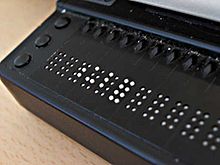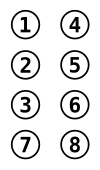Computer glasses

Computer braille is a modification of Braille for use on a computer . Instead of the usual six points, it has two more to represent special characters.
With the introduction of computers it became necessary to change the number of characters in Braille so that each character on the computer corresponds exactly to a single Braille character. With the increase to eight Braille dots, a total of 28 = 256 different characters were possible , as with the 8-bit code of a computer . To this 8-point Braille, known as computer braille, two more points have been added below the six usual points. These eight points are numbered according to the following scheme:
The Braille characters are entered using a Braille keyboard or a normal computer keyboard. Braille is not read on a monitor, but on a Braille display , also called a Braille display , with which the characters are displayed dynamically using small pens. Braille displays are available in many different sizes and variants.
With a special program ( screen reader ) the screen is read out and displayed line by line. The blind computer user does not 'see' the entire screen, but has to read the screen content line by line with his fingers. A very effective working is possible in combination with a normal keyboard. A mouse is not required, for this the blind person has to be able to use a number of keyboard combinations ( shortcuts ).
Eurobraille
Eurobraille is the name given to the assignment of the 256 characters of a Western European character set to the 256 possible 8-point Braille characters of the computer braille. This means, for example, that all 256 characters of an 8-bit character set can be displayed. Each character, whether uppercase or lowercase letter, number or graphic character, etc., is assigned exactly one 8-point Braille character. There are other computer braille definitions outside of Europe.
In fact, there are several character sets that were defined in 1986 as Eurobraille for various Western European languages . The most widely used character set today is ISO 8859-1 , which largely corresponds to the Western European ANSI character set used by Windows . An important principle of Eurobraille is to always display black characters that appear in several of these character sets with the same Braille characters.
Due to the adaptation to different languages and character sets, some changes compared to the 6-point Braille were necessary. Due to these deviations in the point assignment of the 8-point Braille characters (Eurobraille) from those of the 6-point Braille characters (Literature Braille), the usual abbreviations of full text for the blind and shorthand for the blind are not available during normal work on the PC.
Capital letters are formed by adding the point 7, small umlauts are given the point 8, large umlauts are placed downwards. The Braille symbols assigned to phonetic symbols in full script were assigned to numbers, among other things.
The main differences:
Ziffern: (P16) = 1 (P126) = 2 (P146) = 3 (P1456) = 4 (P156) = 5 (P1246) = 6 (P12456) = 7 (P1256) = 8 (P246) = 9 (P346) = 0
Umlaute: (P3458) = ä (P2468) = ö (P12568) = ü (P34568) = ß (P567) = Ä (P358) = Ö (P2368) = Ü
In order to be able to work on the computer, blind people have to learn a number of new characters in addition to Braille . In addition to the capital letters, digits and umlauts, you reckon with around 30 other new characters that you should master.
